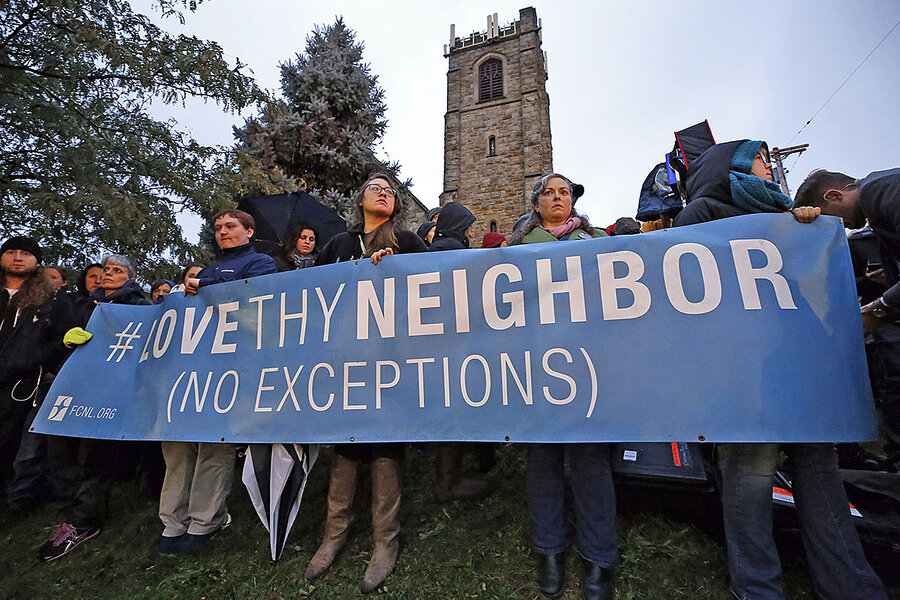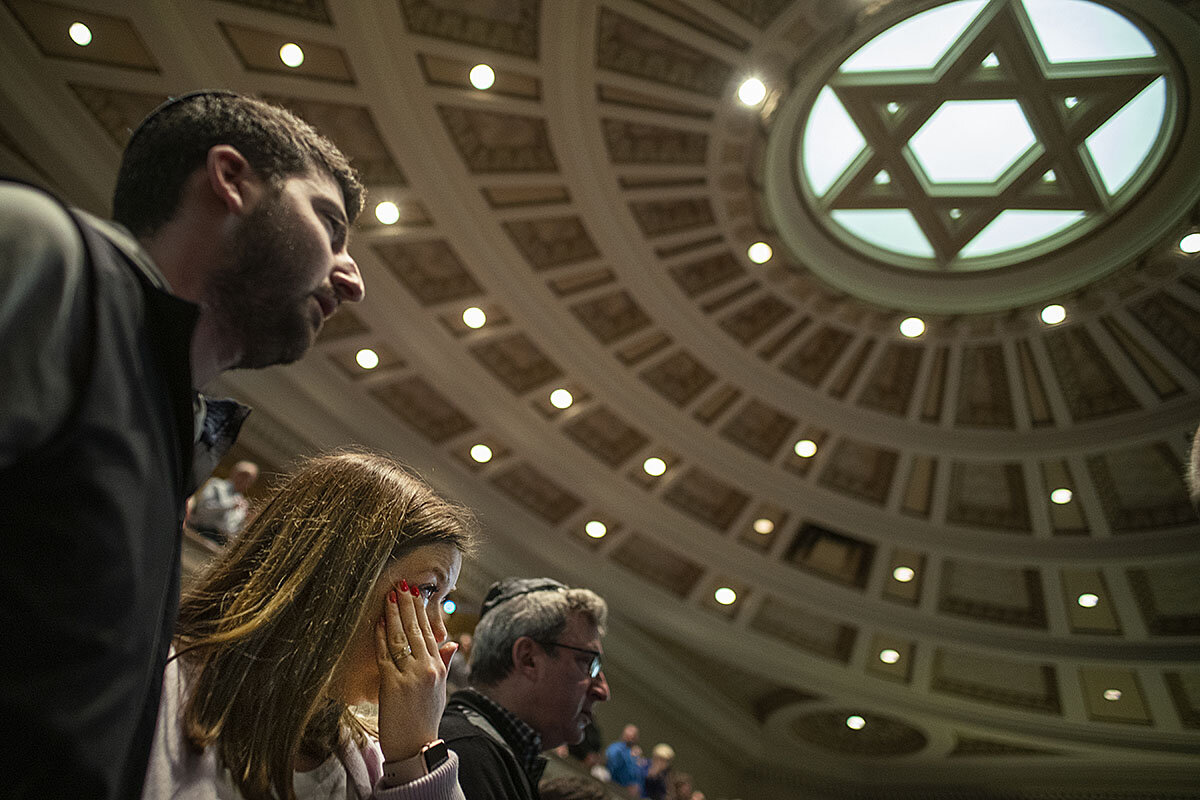‘Lone wolves’ and the rhetoric that fuels them
Loading...
| New York and Amherst, Mass.
To those familiar with him offline, Robert Bowers was barely there.
“He was in his own little world,” said one childhood friend of the man accused of gunning down 11 congregants in Pittsburgh on Saturday in what is likely the deadliest attack on the Jewish community in US, according to The New York Times. “He was pretty much a ghost.”
“There was nothing about him, not even a bumper sticker on his car,” said a neighbor.
Why We Wrote This
When acts of shocking violence start to feel commonplace, it becomes imperative to explore what it is about our society that enables hate to flourish.
He kept to himself, as the stock phrase that inevitably follows a mass shooting goes. Yet, as the research shows, no terrorist is an island, and the alleged Pittsburgh gunman is no exception. Mr. Bowers may have been a phantom in the physical world, but on the right-wing social platform Gab, he was enmeshed in a network of values and norms that have an insidious way of making the murder of elderly Jews look like justice.
“Nobody self-radicalizes,” says Mark Hamm, a professor of criminology at Indiana State University. “They do get radicalized. They go through a process of extremist development. But it is certainly by no means independently.”
Professor Hamm is the co-author of “The Age of Lone Wolf Terrorism,” which looks at 123 cases of lone-actor terrorism from 1940 through mid 2016. These include well-known terrorists, like Martin Luther King Jr.’s assassin, James Earl Ray, as well as lesser-known figures like Hussein Kholya, who in 1983 hijacked an airliner over Texas.
Many Americans this week are wondering, what makes a person resort to such lone wolf attacks, and why do they seem to be happening more and more in America? The attack in Pittsburgh was one of three acts of violence last week, each allegedly perpetrated by middle-aged white men who were in various ways motivated by political and racial hatred.
For many, the state of American political discourse has become more than simply polarized. Expressions of hate and racism abound online, and political pundits serve a steady diet of vitriol.
Many also see the president himself as normalizing a crass and cavalier tone in American politics, using historically loaded terms like “enemy of the people” to refer to the news media, calling immigrant gangs “animals, not people,” and with showman-like bravado, making quips about “knocking the crap out of” protesters at his raucous political rallies.
After the shooting, US House majority leader Kevin McCarthy deleted a tweet that said three Democratic donors of Jewish descent – George Soros, Michael Bloomberg, and Tom Steyer – were trying to “buy” the 2018 midterm elections. The tweet was posted last Tuesday, well before the shooting, but after a pipe bomb had been sent to Mr. Soros’s home. Hours after the shooting, President Trump reposted a tweet by Dinesh D'Souza, a GOP activist who, earlier this year, retweeted the hashtag #burnthejews. Earlier this month, Republican Rep. Steve King of Iowa met with an Austrian far-right group with ties to Nazis. He did so while on a trip funded by a Holocaust memorial group.
The making of a lone wolf
Clearly, the people who make the decision to commit a “lone wolf” act of violence are relatively few, even if their actions reverberate around the world.
“That extremist rhetoric itself doesn't necessarily lead to individual action, because otherwise the question might be, why are there few of these attacks when there's so much basically hate speech out there?” says Ramón Spaaij, author of “Understanding Lone Wolf Terrorism: Global Patterns, Motivations and Prevention” and co-author, with Hamm, of “The Age of Lone Wolf Terrorism.”
But such rhetoric takes on a life of its own on social media, where isolated individuals find like-minded people who help to amplify that rhetoric, experts say.
“They may be enabled by others from a distance, but no no one is giving them commands or directions to carry out these attacks, and certainly no one is helping them go operational,” Hamm says. “These are anonymous online sympathizers who indeed enable the lone wolf through a validation of his ideology. So you have now, all of a sudden, a person [who] is not really truly all alone, because now he has a small online community, but he doesn't know who they are and in real life he doesn’t know their names.”
Some observers have begun to use the term “stochastic terrorism” to refer to the phenomenon of far-reaching online communications “to incite random actors to carry out violent or terrorist acts that are statistically predictable but individually unpredictable.”
This kind of terrorism was put to effective use by tech-savvy manipulators working with ISIS years ago, experts note, leading a number of youth in the West to travel to Syria to volunteer, or for lone wolves to carry out violent acts.
Indeed, there has been “a dramatic increase in attacks by disaffected people, and people searching for some sense of accomplishment,” John Cohen, a counterterrorism coordinator for the Department of Homeland Security, told Quartz in an Oct. 24 interview. Whether white supremacy or Al Qaeda, they are egged on by what they see and hear on social media to commit a violent act.
Those most susceptible are easily swayed by hateful rhetoric, he said, and are often “looking for legitimacy and a sense of validation for their violent tendencies.”
A surge in violent extremism
This past June, the US Department of Justice issued a report on the growing problem of home-grown acts of terror. The report traces a cycle of radicalization and reinforcement in which certain individuals “[embrace] a terrorist belief system or narrative that identifies particular others or groups as ‘enemies’ and justifies engaging in violence against them.”
The cycle often includes a “triggering event” in which an individual, who is often already deeply embedded in online communities that normalize violent extremism against those perceived as dangerous others, passes an inner threshold and makes a decision to kill, researchers say.
And the United States appears to be in the midst of a surge of such extremism, especially of right wing and white nationalist groups. Between 2014 and 2017, the number of hate groups in the US grew from 784 to 953, according to the Southern Poverty Law Center in Montgomery, Ala.
This includes a number of white nationalist militias that engage in paramilitary-style training and guerrilla warfare techniques, notes Christian Picciolini, a former white supremacist and author of “Romantic Violence: Memoirs of an American Skinhead.”
Yet globally, terrorism has declined in the last few years, dropping from about 17,000 incidents in 2014 to about 11,000 in 2017, including about 40 percent fewer terrorist acts in the Middle East and North Africa, according to data from Global Terrorism Database.
In the US however, the numbers are increasing. There were only six acts of home-grown terror 10 years ago, but in 2017 this number grew to 65. Of these, 37 were perpetrated by those with right-wing and racist motives, 11 by left-wing motives, seven by Muslim extremists, and 10 unknown.
“While there is no standard profile of the lone wolf terrorist, most of them are unemployed, single white males with a criminal record,” reported Professors Hamm and Spaaij, in a 2015 study commissioned by the Justice Department. “Compared to members of terrorist groups, lone wolves are older, less educated and more prone to mental illness.”
While mental illness may constitute a piece of the puzzle to understanding lone-actor terrorism, it by no means fully accounts for it. Indeed, a person’s address, says Noemie Bouhana, an associate professor in security and crime science at University College London and an expert in radicalization, can be a more reliable predictor.
“By applying this label of mental illness, [saying] this is someone who of outside society, this is a nutcase,” says Professor Spaiij, “I think the risk we run there is that we fail to hold an attack like that out as a mirror to ourselves, in terms of what does it say about our own social and cultural condition or political conditions that also produces these kinds of attacks?”
For many, the series of events of the past week have been a wake-up call that something about our social and political discourse cannot be ignored.
On Friday, the FBI arrested Cesar Sayoc, an outspoken Trump supporter and self-avowed white supremacist who had attended at least one Trump rally. Mr. Sayoc is suspected of sending a series of at least 14 pipe bombs to well-known critics of Mr. Trump.
On Wednesday, a gunman named Gregory Bush allegedly attempted to barge into a black church near Louisville, Ky. Unable to enter, he went to a nearby Kroger grocery store, where he shot and killed two black people at random.
Like these two men, Bowers, who denigrated President Trump as a “globalist” – “There is no #MAGA as long as there is a k*** infestation,” he once posted on Gab – had a long history of making racist comments online and had a history of violence.
When Bowers walked into The Tree of Life congregation on Saturday and opened fire, his attack struck against the name of this Conservative Jewish congregation in a deeply literal way. He brought hate and death to a celebration of love and life.
But amid their grief, the congregants have refused to meet hate with hate.
“My cup overflows with love,” Tree of Life Rabbi Jeffrey Myers told 2,000 people gathered Sunday in remembrance of the lives lost. “That’s how you defeat hate.”







